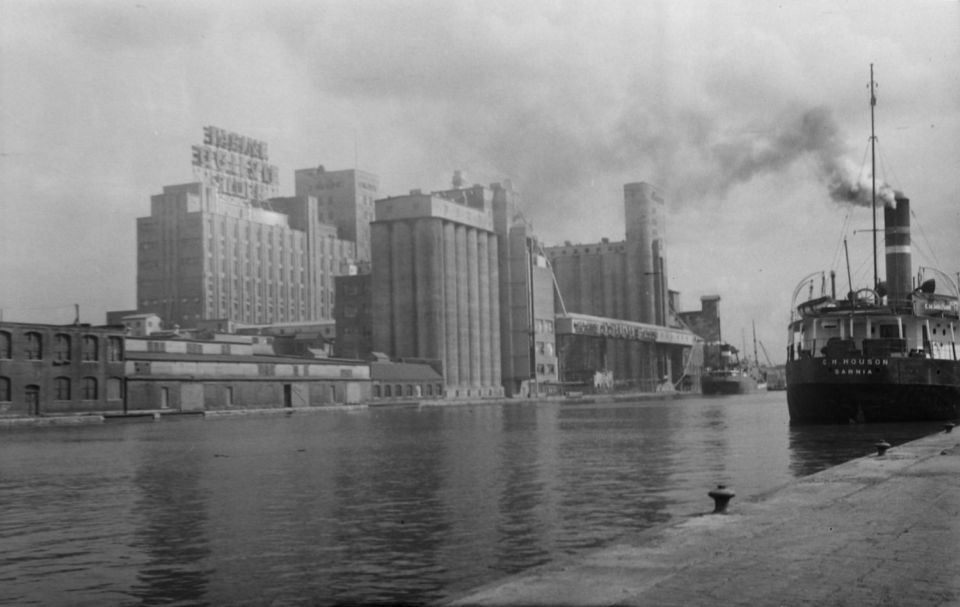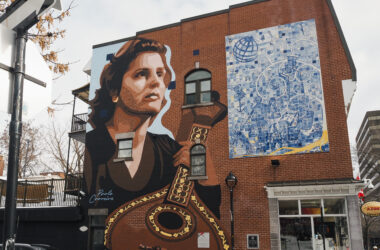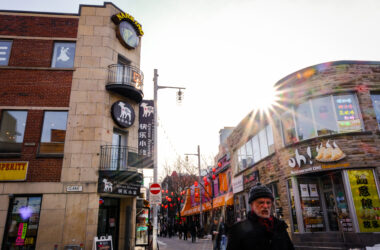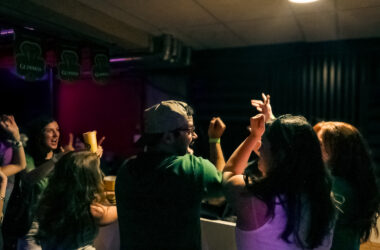In 1962, novelist and filmmaker Hubert Aquin produced September Five at St. Henri, which documented the daily routine of families living in the southwestern, working-class neighbourhood in Montreal.
“St. Henri is not known for fancy restaurants,” Bill Davies, the film’s narrator, comments. “It is really a little island, surrounded by water, railroads, and the industrial wealth of other men.”
Davies’ commentary has hardly aged well. Rue Notre-Dame Ouest, the commercial main street of St. Henri, now boasts a plethora of lavish restaurants with pricey menus. Vintages Frames L’Archive, a sunglasses store on the street, sells designer products for thousands of dollars, and a January Versace ad campaign recently featured 2Chainz sporting a pair of shades that he purchased at the shop. The flamboyance of this new St. Henri is a symptom of a rapid gentrification process: Even though the neighbourhood is home to a distinctly working-class community, rising rent costs coupled with precarious financial circumstances have priced out even long-time residents in favour of more affluent professionals and young students.
While factories hum in the background of Aquin’s film, in the time since, most of St. Henri’s major factories have since closed down and are now abandoned and rusting along the banks of the Lachine Canal. With employment prospects for working-class individuals dwindling away over the decades, the neighbourhood has faced immense economic pressures, and the population has sharply declined. The Arrondissement du Sud-Ouest, of which St. Henri occupies the northwestern quarter, lost 38 per cent of its population between 1966 and 2006, according to Montreal City statistics. That population did not start to grow again until the mid-2000s, as economic redevelopment along the Lachine Canal accelerated.
In the aftermath of deindustrialization, real estate groups renovated abandoned factories into new houses and condominiums. In 1993, developers purchased 4710 rue St-Ambroise, which had been a Simmons Bedding Company factory since 1919, and refurbished it into a luxury loft building. With a Parks Canada investment dedicated to beautifying the areas around the old industrial area, the canal, which once housed the heart of Canada’s manufacturing economy, now features bike lanes, recreational boating opportunities, and music festivals. Private companies have continued to assume old factories and warehouses along the canal, turning them into luxury condos with prices starting at well over $300 thousand for a simple studio. McGill even capitalized on the abandoned factory market in St. Henri—in 1990, the university purchased a former chocolate factory and renovated into what is now Solin Hall, its second-largest student residence that houses upward of 280 students.
These economic and demographic changes have had adverse effects on remaining long-term residents. As factories closed and the population dwindled, entrepreneurs soon bought cheapened property in the area and started new businesses. Howard Zinman, the senior administrative coordinator of Solin Hall, has witnessed St. Henri’s changing landscape since he started working there in the early 2000s.
“When I first got to St. Henri, Notre-Dame [street] was filled with collectible shops. You could have found vintage Barbies, Coca-Cola things,” Zinman said in an interview with The McGill Tribune. “I feel like the Internet and the way it affects commerce really stabbed at the heart of Notre-Dame […] For a while, Notre-Dame was a ghost town. [Because of sites like eBay,] the collectible shops closed, there was really nothing there [aside from staples like New System and Greenspot].”
Zinman noticed many empty commercial properties go up for sale during this time. An eclectic variety of small businesses, ranging from mattress to pet lizard stores, filled in the vacancies, but not all of them stayed open.
“The most random businesses that you could think of would pop up [on Notre-Dame],” Zinman said. “People tried different things […] but, there were so many vacancies. Then, the cafés kind of just started opening [one day].”
New condos and trendy businesses have made the neighbourhood seem increasingly attractive to students and young professionals looking to settle down in an area close to the downtown core. Jérémie Lapikas, U1 Arts, who grew up across the canal from St. Henri in Ville-Émard, recalls seeing new arrivals to St. Henri over the years.
“You really have this up-and-coming street, Notre-Dame, where it’s slowly becoming the place to be,” Lapikas said. “There’s lots of places to just consume, basically.”
With all of the condos, fancy barber shops, brunch restaurants, and cafés, an influx of new money has come to St. Henri.
“It’s typically young businesspeople [who frequent these places],” Lapikas said. “I see people wearing brand clothing more and more [even though] it’s still very much a family neighbourhood.”
While high-end condo developers, trendy aesthetics, and the educated mid-twenty-somethings they attract are more responsible for gentrifying St. Henri, university students also play a noticeable role in pushing long-time residents out of their homes.
“Many students who lived here, going back to the first years of Solin, after they leave rez after first year, [they] stay in St. Henri,” said Zinman. “There [are also] a lot of people who, once they’ve lived here and maybe moved to the Ghetto, come back here afterward.”
For students at McGill and other Montreal universities, St. Henri’s appeal extends far beyond its trendy cafés. Compared to the increasingly-pricier Plateau and Milton-Parc neighbourhoods, St. Henri has relatively inexpensive rent for student budgets. Commuting to the Downtown campus only takes 10 to 15 minutes by metro, and cheap grocery stores, like Super C and various local markets, are abundant in the area. While this is an attractive setup, Lapikas stated that students resettling in the area need to remember that their actions have consequences.
“You have this wave of students coming in, and it’s hard to blame them because if you can find an apartment which is reasonably priced, and you team up with a bunch of people and split rent it makes sense,” Lapikas said. “But, that’s putting families, especially single-income families, in a very competitive housing environment. As a single parent, it’s much harder to match whatever four students can pool together. But you need that space if you have three kids.”
To combat this problem, community organizations have worked to advocate for awareness of gentrification at City Council. Other more militant activists have smashed in windows of trendy-looking businesses. Lapikas suggested that students could also help by volunteering in the neighbourhood and integrating themselves into St. Henri more.
“I don’t think the solution is to try to reverse the process and make these neighbourhoods ‘working class’ again, but to try to split more evenly the benefits of better stores,” Lapikas said. “It’d be nice to see more interaction with students who just come here for four years and the locals who lived their entire lives here.”
However, not all new stores cater to multimillionaires like Lady Gaga and Nas. Despite Notre-Dame’s many changes, locals have taken a leading role in shaping St. Henri in a less ostentatious fashion. Charity organizations like Les Ami(e)s de Montréal sell inexpensive second-hand furniture, and St. Henri locals own the Singaporean street food restaurant, Satay Brothers. When new residents support long-time residents of the neighbourhood, they can lessen their impact on the gentrified area.
“I love those guys because they were born and grew up in St. Henri, and they employ people from the neighbourhood,” Zinman said. “So, even though I find them a little expensive […], to me, [Satay Brothers] is a great St. Henri success story. But, I can see how someone from the outside could look at that and see it as gentrification [in action].”








